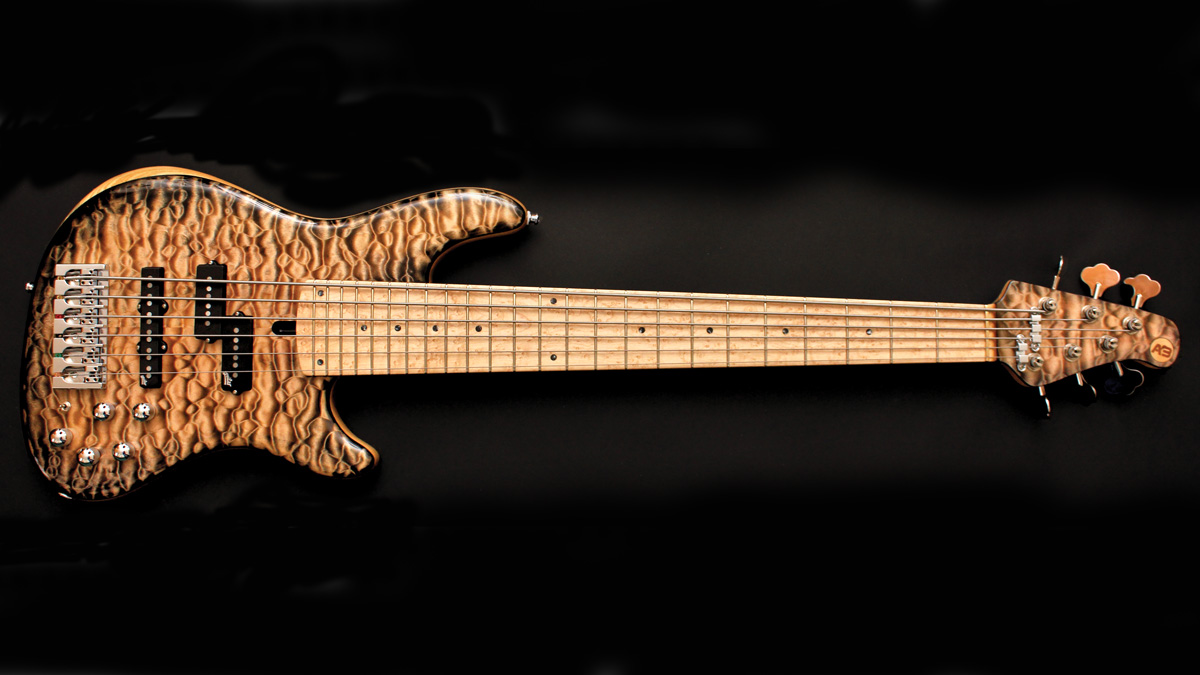MusicRadar Verdict
A breathtaking instrument that will supply a lifetime of bass tones.
Pros
- +
Superb build.
- +
State-of-the-art tones.
Cons
- -
Epic dimensions.
- -
Less epic bassists may prefer a smaller/lighter choice.
MusicRadar's got your back
London’s Anaconda Basses has established an enviable track record in recent years, issuing instruments of phenomenal quality and asking a recession-defying RRP in return.
We’ve been consistently impressed with luthier Andrew Taylor-Cummings’ approach to design and execution and always jump at the chance to review his new creations. This six-string version of his Ultra J range looks almost indescribably tasty to us, as indeed it should for nearly three thousand quid of your taxed income - so let’s plug, play and pontificate...
Build
Pull the J6E out of the Hiscox case in which it is supplied and you quickly realise why bass pundits practically regard six-string basses as completely different instruments to your average fours and fives.
At 4.5kg, it’s relatively lightweight, but it doesn’t lack presence. Twin carbon rods reinforce the neck, a slab of wood anchored to the body by no fewer than six offset bolts - offset, as Taylor-Cummings tells us, to solve the micromillimetrically tiny wobble problem that parallel rows inevitably produce.
Assuming you have big enough muscles, or at least sufficient body mass, to wield this instrument, you’ll need hands to match. Of course, the string spacing and neck pro le have been specifically designed to enable comfortable playing, but this is no John Myung-style, six-strings-on-a- five-string-neck deal.
Solid Hipshot machine heads and a weighty bridge hold down the strings across a 34.5” scale length, a nice compromise (as we’ll see) between the standard 34” which so many B-string lovers feel is too short and the 35” which makes the headstock look miles away. The ‘Luminlay’ side markers, chargable with the supplied LED torch, are luminescent but subtle; perfect if you don’t want your bass to look like a midnight traffic jam on the M4.
The body woods look unfeasibly beautiful, with a state-of-the-art slinky finish. You may or may not be generally keen on the concept of yellow-brown tiger stripes, which admittedly sound a bit Van Halen on paper; in the flesh (as it were) the colour scheme is both subtle and pleasing. Note that the outer edges of the body contours have been left a natural colour; there’s no unnecessary showing-off here.
Want all the hottest music and gear news, reviews, deals, features and more, direct to your inbox? Sign up here.
As always, when we review an expensive bass like this one, we make a point of examining the finer details. A sharp fret end here and there isn’t the end of the world on a £199 Precision copy, but it is when you’re paying as much for a bass as you would for 15 of said cheap instruments. We’re happy to report that Anaconda have designed and built this instrument with the highest quality in mind, so there’s a handmade wooden cavity cover (not a plastic one), an offset rear strap button (for better balance), high-quality control pots, and so on from the tuners to the tail.
Sounds
Direct your attention to the Ultra J’s lower bout and there you’ll find a series of pots which turn stiffly but smoothly - and when you’ve played as many cheap basses as we have, you’ll enjoy the feeling of slight resistance as they turn. There’s nothing worse than a lightweight tone control that feels as if it’s going to fall off.
Select passive mode by pulling out the volume pot. We always do this first when testing active basses, as it reveals the instrument’s ‘normal’ sound before any battery power is applied to the tone range. The Ultra J in passive mode is a wonderful instrument with a naturally full midrange and perfectly decent performance at top and bottom. The Treble pot functions as the passive tone, and if this was as far as this bass went, we’d still be reasonably impressed.
Of course, the preamp is there for a reason, so switch to active and you’ll be rewarded with full bass and a crispy top end. A pickup blend adds flexibility, and a three-position mid centre selector allows you to ‘move’ the midrange up and down - a useful touch if you’ve ever needed to push your sound out of the mix sufficiently to be heard.
In terms of how well this bass plays, you need to commit to giving it due care and attention to maximise its performance. Some basses almost do your job for you, repaying the slightest touch; this isn’t one of those. Play tight and hard and apply careful muting - Scott Devine recommends using the back of your fretting-hand thumb on a six-string, and we agree whole-heartedly - and the Ultra J kicks back at you with a meaty, thunderous but controlled bottom end.
There’s a whole world of mids to explore, of course, and that top end is no slouch either, but we feel that this bass is most at home with staccato low end as per reggae, soul, R&B or plain old pop. The low B-string feels especially solid because of the extra half-inch on the scale, and you’re more willing to incorporate it into your playing as a result, rather than treating it as an expensive thumb rest.
This is a big bass which requires dedication, so if you’re looking for a slick play and an easily portable body, look elsewhere. However, if your bass-playing requires a heavy, powerful, high-performance instrument, this one absolutely has to be on your to-try list. Its price tag will seem far more reasonable when you’ve experienced its physical presence, not to mention the glistening quality of the components. Hats off yet again to Anaconda.
